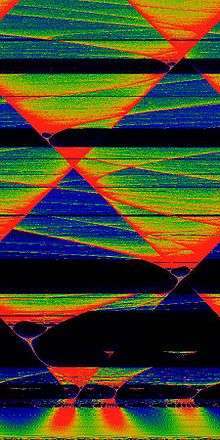Floris Takens

(photo from Mathematical Research Institute of Oberwolfach)
Floris Takens (November 12, 1940 – June 20, 2010)[1] was a Dutch mathematician known for contributions to the theory of chaotic dynamical systems.
Together with David Ruelle, he predicted that fluid turbulence could develop through a strange attractor, a term they coined, as opposed to the then-prevailing theory of accretion of modes. The prediction was later confirmed by experiment. Takens also established the result now known as the Takens' theorem, which shows how to reconstruct a dynamical system from an observed time-series.
Takens was born in Zaandam in the Netherlands. He attended schools in The Hague and in Zaandam before serving in the Dutch army for one year (1960–1961). At the University of Amsterdam he concluded his undergraduate and graduate studies. He was granted a doctorate in mathematics in 1969 under the supervision of Nicolaas Kuiper for a thesis entitled The minimal number of critical points of a function on a compact manifold and the Lusternik–Schnirelmann category.
After his graduate work, Takens spent a year at the IHES, in Bures-sur-Yvette, near Paris, where he worked with David Ruelle, René Thom, and Jacob Palis. His friendship with Palis has taken him many times to the Instituto de Matemática Pura e Aplicada, IMPA, in Rio de Janeiro, Brazil. Their collaboration produced several joint publications.
Takens was a professor at the University of Groningen, in Groningen, Netherlands from 1972 until he retired from teaching in 1999.[2]
Takens was member of:
- The Royal Netherlands Academy of Arts and Sciences (since 1991)[3]
- The Brazilian Academy of Sciences (since 1981), and
- The editorial board for the Springer-Verlag's Lecture Notes in Mathematics.
Selected publications
- D. Ruelle; F. Takens (1971). "On the nature of turbulence". Communications in Mathematical Physics. 20 (3): 167–192. doi:10.1007/BF01646553.
- F. Takens (1981). "Detecting strange attractors in turbulence". Lecture Notes in Mathematics. pp. 366–381.
- Sheldon E. Newhouse; Jacob Palis, Jr.; Floris Takens (1983). "Bifurcations and stability of families of diffeomorphisms". Publications Mathématiques de l'IHÉS. 57: 1–71.
See also
Notes
- ↑ rug.nl (retrieved 30 October 2010)
- ↑ dynamicalsystems.org (retrieved 30 October 2010)
- ↑ "Floris Takens (1940 - 2010)". Royal Netherlands Academy of Arts and Sciences. Retrieved 17 July 2015.
References
- Henk W. Broer, Bernd Krauskopf, and Gert Vegter, Editors (2001). Global Analysis of Dynamical Systems festschrift dedicated to Floris Takens for his 60th birthday. IOP Publishing. ISBN 0-7503-0803-6.
- Floris Takens - Academia Brasileira de Ciências. Accessed on 26 January 2010.

